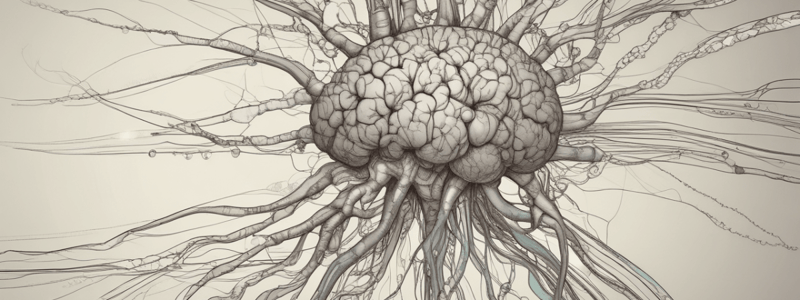Podcast
Questions and Answers
Which of the following is NOT a function of neuroglia?
Which of the following is NOT a function of neuroglia?
- Maintaining the blood-brain barrier
- Transmitting information to other neurons (correct)
- Providing nutrients to neurons
- Providing structural support for neurons
Which of the following is NOT a component of the central nervous system (CNS)?
Which of the following is NOT a component of the central nervous system (CNS)?
- Cranial nerves (correct)
- Brainstem
- Spinal cord
- Brain
Which part of the brain is responsible for coordinating voluntary movements and maintaining balance?
Which part of the brain is responsible for coordinating voluntary movements and maintaining balance?
- Brainstem
- Cerebellum (correct)
- Cerebrum
- Spinal cord
The autonomic nervous system (ANS) is primarily involved in the regulation of which of the following?
The autonomic nervous system (ANS) is primarily involved in the regulation of which of the following?
Which of the following cranial nerves is responsible for controlling eye movements?
Which of the following cranial nerves is responsible for controlling eye movements?
Which of the following is a characteristic of white matter in the CNS?
Which of the following is a characteristic of white matter in the CNS?
Which of the following is NOT a function of neurons?
Which of the following is NOT a function of neurons?
What is the primary function of neurons in the nervous system?
What is the primary function of neurons in the nervous system?
What is the estimated number of neurons in the human nervous system?
What is the estimated number of neurons in the human nervous system?
Which part of the nervous system facilitates and controls fine motor skills?
Which part of the nervous system facilitates and controls fine motor skills?
What is the role of the nervous system in encoding, storing, and retrieving memories?
What is the role of the nervous system in encoding, storing, and retrieving memories?
What happens at the neural level during reflex actions?
What happens at the neural level during reflex actions?
What is the difference between the Central Nervous System (CNS) and the Peripheral Nervous System (PNS)?
What is the difference between the Central Nervous System (CNS) and the Peripheral Nervous System (PNS)?
What is the role of neuroglia in the nervous system?
What is the role of neuroglia in the nervous system?
What is the primary role of the enteric nervous system?
What is the primary role of the enteric nervous system?
What are the cranial nerves primarily responsible for?
What are the cranial nerves primarily responsible for?
Which statement best describes the spinal nerves?
Which statement best describes the spinal nerves?
Which of the following accurately differentiates the central nervous system from the peripheral nervous system?
Which of the following accurately differentiates the central nervous system from the peripheral nervous system?
What role do neuroglial cells play in the nervous system?
What role do neuroglial cells play in the nervous system?
How do autonomic nervous system pathways operate in relation to bodily functions?
How do autonomic nervous system pathways operate in relation to bodily functions?
What distinguishes the organization of cranial nerves from spinal nerves?
What distinguishes the organization of cranial nerves from spinal nerves?
Flashcards are hidden until you start studying
Study Notes
Neurons and Neuroglia
- Neurons are the main functional units of the nervous system, with approximately 10 billion present in humans.
- Neuroglia outnumber neurons by about ten times, playing a crucial role in maintaining normal functioning and complementing neural communication.
- Neuroglial cells do not participate directly in information processing.
Nervous System Components
- The nervous system is divided into the Central Nervous System (CNS) and Peripheral Nervous System (PNS).
- The CNS includes the brain (cerebrum, brainstem, cerebellum) and spinal cord.
- The PNS comprises cranial nerves, spinal nerves, ganglia, and peripheral receptors.
Central Nervous System (CNS) Structure
- The cerebrum contains the frontal, parietal, temporal, and occipital lobes and houses nuclei for olfactory (CN I) and optic (CN II) nerves.
- The brainstem is comprised of the midbrain (CN III and IV), pons (CN V, VI, VII), and medulla oblongata (CN IX, X, XI, XII).
- The spinal cord serves as a major conduit for signals traveling to and from the brain.
Gray Matter and White Matter
- Gray matter consists mainly of cell bodies and is involved in processing information.
- White matter is composed predominantly of myelinated axons and facilitates communication between different regions of the CNS.
Peripheral Nervous System (PNS)
- The PNS includes 31 pairs of spinal nerves and 12 pairs of cranial nerves.
- The system has two primary divisions: the somatic system and the autonomic nervous system.
- Sensory neurons transmit information from sensory organs to the CNS, while motor neurons carry signals from the CNS to skeletal muscles.
Autonomic Nervous System (ANS) Functions
- The ANS regulates involuntary bodily functions for homeostasis and has two main subdivisions:
- Sympathetic Nervous System (SNS): Triggers "fight or flight" responses; associated with thoracic and upper lumbar spinal regions. Increases heart rate and redirects blood flow to muscles.
- Parasympathetic Nervous System (PNS): Promotes "rest and digest" responses; linked to cranial nerves III, VII, IX, and X, as well as sacral nerves; slows heart rate and aids in digestion.
Learning Outcomes
- Understand the differences between CNS and PNS and their major components.
- Comprehend structural and functional distinctions in cranial and spinal nerves.
- Master relevant neuroscience terminology.
Reflex Actions and Fine Motor Skills
- Reflex actions, such as pulling away from a hot object, demonstrate rapid neural processing.
- Precise movements (e.g., threading a needle) require coordinated motor control mediated by the nervous system.
- Memory processes (encoding, storing, retrieval) also involve complex neural interactions.
Studying That Suits You
Use AI to generate personalized quizzes and flashcards to suit your learning preferences.




